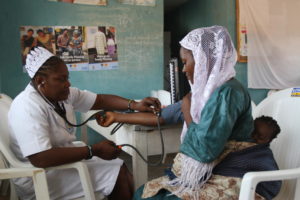 For a service delivery program to be successful, clients must access services, communicate effectively with providers, and adopt and maintain healthy behaviors. Social and Behavior Change Communication (SBCC) plays an integral role in achieving each of those outcomes. Using SBCC across the continuum of care (before, during and after services) can enhance the impact of a service delivery program by:
For a service delivery program to be successful, clients must access services, communicate effectively with providers, and adopt and maintain healthy behaviors. Social and Behavior Change Communication (SBCC) plays an integral role in achieving each of those outcomes. Using SBCC across the continuum of care (before, during and after services) can enhance the impact of a service delivery program by:
- Creating an enabling environment
- Getting clients to services
- Improving the client-provider interaction
- Supporting behavioral maintenance
HC3 has developed a variety of resources to support SBCC work along the continuum of care, including the following:
Circle of Care: Strategic Communication for Social and Behavior Change (SBC) Along the Service Delivery Continuum
HC3 developed the Circle of Care model to illustrate how strategic communication can be used along the service delivery continuum. The model is intended for program managers, donors and anyone interested in designing or implementing service delivery programs. The Circle of Care model illustrates how SBC can be integrated at three key points or stages along the continuum: 1) Before Services; 2) During Services and 3) After Services.
Video: SBC Along the Service Delivery Continuum
This animated video showcases how SBC can be used along the service delivery continuum to improve health outcomes. It walks viewers through the Circle of Care model (above), describing SBC’s role at each stage of the continuum—before, during and after services. It highlights real country-level experiences using SBC at various stages.
Provider Behavior Change Implementation Kit
These I-Kits are designed to help users change provider behaviors that impede quality service provision. One I-Kit places Facility-Based Providers as the primary audience for SBCC and the other places Community Health Workers as the primary audience. Both I-Kits include an Assessment Tool that helps users identify, understand and prioritize provider-related barriers to quality service provision; an Intervention Design Tool that provides step-by-step guidance on designing an SBCC intervention to address the identified barriers; and a collection of Resources that showcase effective provider behavior change interventions.
Long-Acting Reversible Contraceptives Collection
To address knowledge gaps and help providers counsel young women on Long-Acting Reversible Contraceptives (LARCs), HC3 created a collection of SBCC materials for increased youth access to LARCs (ages 15-24). The materials include:
- A three-minute animated video aimed at providers who may counsel young women about modern contraceptive methods
- A video discussion guide to help program managers or health facility senior staff facilitate deeper dives into the video’s key messages
- A take-home brochure (in two versions: one with photos, one with stills from the animated video) that provides information on LARCs for dissemination in clinical and non-clinical settings
- A series of posters encouraging youth to find out more information on LARCs and consider them as an appropriate method
The materials can be adapted and used in a variety of ways. For example, PSI recently used the materials in a training for 15 members of the quality assurance team of PACE, PSI’s local affiliate in Uganda, as part of a five-day training of trainers on delivering youth-friendly health services.
Healthy Timing and Spacing of Pregnancy Implementation Kit
The Healthy Timing and Spacing of Pregnancies I-Kit for Women of Advanced Maternal Age (AMA) and High Parity (HP) is designed to help program managers address the risks of pregnancies among women of advanced maternal age (age 35 and older) and women having five or more births in their family planning or maternal and child health programs. Among other tools, the I-Kit contains several materials for use in service delivery, including:
- A counseling guide for providers
- A reminder poster for providers
- A client brochure with versions for more conservative and less conservative audiences
- A set of infographics for health priority decision-makers
The materials are adaptable and are also available in French.
Integrating SBCC into Service Delivery Programs Implementation Kit
HC3 has developed an Integrating SBCC into Service Delivery Programs I-Kit that provides tailored guidance on using SBCC in a service delivery context. The I-Kit demonstrates how SBCC can be used at three key stages to enhance the impact of a service delivery program: 1) before – by getting clients to services; 2) during – by improving the client experience; and 3) after – by supporting behavioral maintenance. The I-Kit outlines SBCC’s role in service delivery and highlights where, when, and how to use it. The first section provides guidance on how to integrate SBCC into service delivery or coordinate with SBCC partners. The second section presents case studies that highlight how SBCC helped a service delivery organization overcome challenges at each stage.
Smart Client
HC3 is developing an mHealth tool called Smart Client using interactive voice response (IVR), supported by short messaging service (SMS), that can reach clients directly to emphasize the importance of being an informed and engaged family planning client. Smart Client is comprised of a series of short drama episodes with supporting messages and personal testimonials. The tool is designed to be adaptable to multiple country contexts but will be initially launched in Nigeria.
Malaria in Pregnancy Guide
HC3 developed the SBCC for Malaria in Pregnancy (MiP) I-Kit with an important focus on service providers as a primary audience for SBCC interventions. This resource is meant to be used as a supplemental resource to improve the design of social marketing or communication strategies that promote MiP services and commodities. It includes a number of considerations and examples that draw on actual strategies and recent technical guidelines, and identifies further resources where appropriate.
